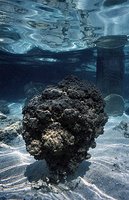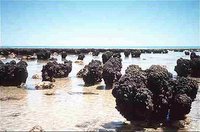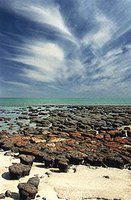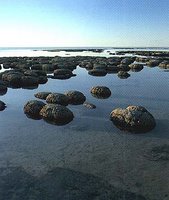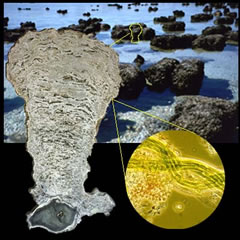In Search of the Simplest Cell
Hypothesis: the origin of life in a hydrogel environment. : "A hypothesis is proposed that the first cell(s) on the Earth assembled in a hydrogel environment. Gel environments are capable of retaining water, oily hydrocarbons, solutes, and gas bubbles, and are capable of carrying out many functions, even in the absence of a membrane. Thus, the gel-like environment may have conferred distinct advantages for the assembly of the first cell(s)."
Trevors JT, Pollack GH. Prog Biophys Mol Biol. 2005 Sep;89(1):1-8. Hypothesis: the origin of life in a hydrogel environment.
Possible impact of a primordial oil slick on atmospheric and chemical evolution.: "Low molecular weight liquid hydrocarbons from various sources, could have formed an oil layer covering the primeval ocean (present already 4.0-4.4 x 10(9) yr ago), preventing water from evaporating into the atmosphere. Water from other sources, precipitated by cold traps at higher altitude in the atmosphere, becomes trapped in the ocean. In a thereby more dry and presumably reducing atmosphere (before 3.9 x 10(9) yr ago) even more hydrocarbons, as well as reactive molecules will form. An oil layer can possibly act as a dry solvent for reactions, where the reactive molecules can produce monomers and condensing agents. Monomers and eventual polymers formed could become strongly concentrated at the oil-water interface, favouring molecular interactions at high mobility and low dilution, without exposure to the destructive action of UV-light. Increased water leakiness of the oil layer due to accumulation of polar molecules within, would lead to photooxidation of liquid hydrocarbons, and subsequent emulsification at the oil-water interface, forming cellular structures. The atmosphere would then have lost its reducing character."
Nilson FP. Possible impact of a primordial oil slick on atmospheric and chemical evolution. Orig Life Evol Biosph. 2002 Jun;32(3):247-53.
Growth of organic microspherules in sugar-ammonia reactions : "Reaction of small sugars of less than four carbons with ammonia in water yielded organic microspherules generally less than ten microns in size. The time course of microspherule growth was examined for the D-erythrose-ammonia reaction that yielded microspherules attached to the glass walls of containers. Measurements were made of the elemental composition and infrared spectrum of the microspherule material. These viscose semi-solid microspherules are viewed as possible containers for prebiotic catalytic processes relevant to the origin of life."
Weber AL. Growth of organic microspherules in sugar-ammonia reactions. Orig Life Evol Biosph. 2005 Dec;35(6):523-36.
The possible origin of the first cell biosystem in the thermal subsurface environment of the earth. : "Bacteria are the simplest living biosystems or organisms that exhibit all the characteristics of life. As such, they are excellent models to examine the cell as the basic unit of life and the cell theory which states that all organisms are composed of one or more similar cells. In this article I examine the hypothesis that the primordial soup so often referred to in science was possibly an oil/water interface and/or emulsion in the Earth's, warm, anaerobic subsurface. This warm subsurface location, protected from surface radiation, could have been a favourable location for the assembly of the first bacterial cells on the Earth capable of growth and controlled division or the first biosystem."
Trevors JT. The possible origin of the first cell biosystem in the thermal subsurface environment of the earth. Riv Biol. 2004 Jan-Apr;97(1):79-90.
An archaeal antioxidant: characterization of a Dps-like protein from Sulfolobus solfataricus. : "Evolution of an oxygenic atmosphere required primordial life to accommodate the toxicity associated with reactive oxygen species. We have characterized an archaeal antioxidant from the hyperthermophilic acidophile Sulfolobus solfataricus. The amino acid sequence of this approximately 22-kDa protein shares little sequence similarity with proteins with known function. However, the protein shares high sequence similarity with hypothetical proteins in other archaeal and bacterial genomes. Nine of these hypothetical proteins form a monophyletic cluster within the broad superfamily of ferritin-like diiron-carboxylate proteins. Higher order structural predictions and image reconstructions indicate that the S. solfataricus protein is structurally related to a class of DNA-binding protein from starved cells (Dps). The recombinant protein self assembles into a hollow dodecameric protein cage having tetrahedral symmetry (SsDps). The outer shell diameter is approximately 10 nm, and the interior diameter is approximately 5 nm. Dps proteins have been shown to protect nucleic acids by physically shielding DNA against oxidative damage and by consuming constituents involved in Fenton chemistry. In vitro, the assembled archaeal protein efficiently uses H2O2 to oxidize Fe(II) to Fe(III) and stores the oxide as a mineral core on the interior surface of the protein cage. The ssdps gene is up-regulated in S. solfataricus cultures grown in iron-depleted media and upon H2O2 stress, but is not induced by other stresses. SsDps-mediated reduction of hydrogen peroxide and possible DNA-binding capabilities of this archaeal Dps protein are mechanisms by which S. solfataricus mitigates oxidative damage."
Wiedenheft B, Mosolf J, Willits D, Yeager M, Dryden KA, Young M, Douglas T. An archaeal antioxidant: characterization of a Dps-like protein from Sulfolobus solfataricus. Proc Natl Acad Sci U S A. 2005 Jul 26;102(30):10551-6. Epub 2005 Jul 15.Free Full Text article | 1 Guide-Glossary










































